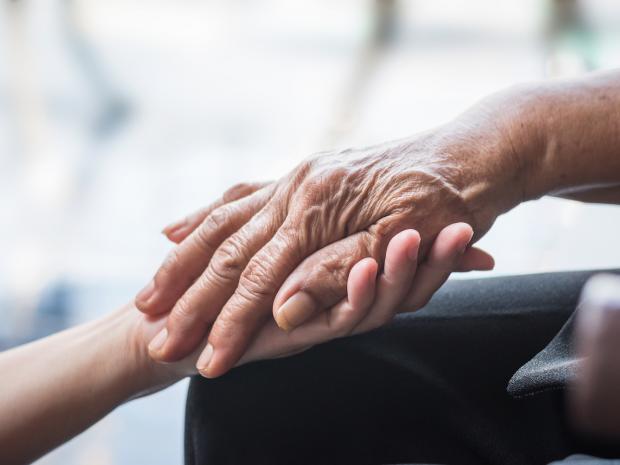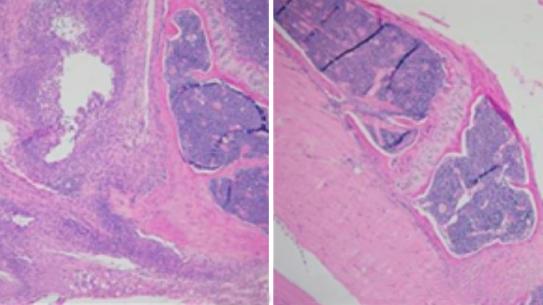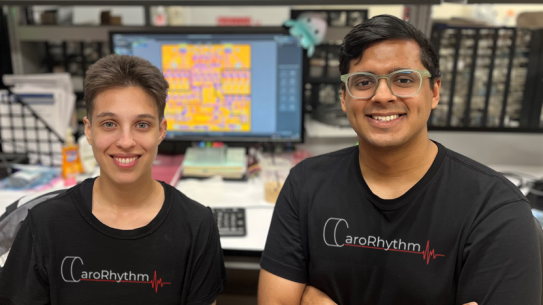Addressing the needs of an aging population

When it comes to life expectancy, there’s good news. People today are living longer than at any other time in history. In the U.S., statisticians note that 2024 is poised to be a record-setting year for those reaching retirement age, with some 11,000 Americans a day celebrating a 65th birthday — a phenomenon dubbed the “silver tsunami.” And according to the World Health Organization, by 2050 it’s estimated that there will be 2.1 billion people over the age of 60.
NYU Tandon researchers are working to understand the evolving health and lifestyle needs posed by increased longevity — and to engineer new ways to meet them.
Joint ventures
A recent National Health Interview Survey revealed that an estimated 53.2 million adults in the U.S. had been diagnosed with arthritis, a debilitating condition causing swelling, stiffness, and tenderness in the joints.
The polysaccharide Hyaluronan is a promising tool in the quest to bring patients relief, and Professor Emerita Mary Cowman has been internationally recognized for her pioneering work with that unique molecule, an important component of the vertebrate biomatrix between and surrounding our cells. She has made significant contributions to the therapeutic use of the substance, which functions as a natural biosensor that promotes cellular responses to inflammation — making it valuable in treating arthritis and other inflammatory conditions. She and Associate Professor of Chemical and Biomolecular Engineering Jin Ryoun Kim have also been recognized for their work with a novel peptide, Amilo 5-MER, that possesses broad therapeutic potential to combat chronic inflammation in multiple diseases, including arthritis.

For the most part, however, direct therapies have eluded researchers’ grasp. But now, Professor of Chemical and Biomolecular Engineering Jin Kim Montclare and investigators from the NYU Grossman School of Medicine have found both the molecular vehicle and therapeutic payload for delivering pharmacologic treatment to affected joints, halting post-traumatic osteoarthritis onset and progression.
Meanwhile, Professor of Biomedical Engineering Thorsten Kirsch, who also serves as NYU Langone’s Vice Chair for Research in Orthopaedic Surgery and Director of the Musculoskeletal Research Center, is studying the novel mechanisms involved in regulating cartilage homeostasis, maintenance, and pathology, with the ultimate goal of defining novel therapeutic targets for the treatment of osteoarthritis, and, in the search for a simple, reliable, non-invasive and low-cost imaging technique that can objectively assess and monitor arthritis progress, Department of Biomedical Engineering Chair Andreas Hielscher is leveraging optical tomography.
Taking heart
Although lifestyle factors such as smoking or being sedentary contribute to coronary heart disease, age presents the main risk: over 80 percent of deaths from heart ailments occur among people older than 65.
Ever since alum William Bennett Kouwenhoven (1906, 1907) helped create the first closed-chest cardiac defibrillator and discovered that pressing rhythmically on a patient’s chest could cause the blood to circulate, leading to the development of manual CPR, Tandon researchers have been working to mitigate the risks of coronary-related fatalities.
Another alum, Barouh Berkovits (1956), invented the “demand pacemaker,” which monitors heart rhythm and sends electrical pulses only if the heart is beating too slow or misses a beat. Medical historians point to his work as the impetus for the modern hospital cardiac-care unit.
But while they set the standard back then, Tandon students, faculty, and alumni are still making enormous strides in the field. Take Assistant Professor of Biomedical Engineering Irene de Lázaro, who in addition to her post at Tandon, is a member of NYU's Cardiovascular Research Center and holds a cross-appointment to Langone’s Division of Cardiology. In her NanoBioEngineering for Tissue Reprogramming and Regeneration Laboratory, she is investigating the mechanisms by which cells reprogrammed in-vivo contribute to regeneration — work that could one day make it possible to regenerate or build an entire heart or other vital organ.
Another Tandon researcher, Associate Professor of Mechanical and Aerospace Engineering and Biomedical Engineering Weiqiang Chen, was recently elected as a Fellow of the American Heart Association (AHA) for his body of work, which includes analyzing individual vascular smooth muscle cells in abdominal aortic aneurysm (AAA), an enlarged area in the major vessel that supplies blood to the aorta that is often called “the silent killer” because most go undetected until they rupture. His research, which involved using cutting-edge ultrasound tweezers not only shed light on the physiological differences between healthy and diseased cells, but helped clinicians predict the progression of AAA and assess potential drug effectiveness. (One of Chen’s graduate students, Kate Luu, was also recently recognized by the AHA, which awarded her a prestigious predoctoral fellowship for her studies of vascular cell mechanobiology.)

Cardiac Care
Research masterstrokes
Strokes are the leading cause of age-related motor disabilities and are responsible for one in six deaths from cardiovascular disease. Because strokes can cause devastating brain damage within minutes, early prevention is especially key. So where do you look for clues to a potential stroke? Your eyes. Thanks to a project called EyeScore, co-developed by S. Farokh Atashzar, assistant professor of Electrical and Computer Engineering, as well as Mechanical and Aerospace Engineering, we may soon have technology that uses non-invasive scans of the retina to predict the recurrence of stroke in patients by analyzing those images using machine learning and flagging potentially troublesome developments.
Caro Rhythm is another early-warning system being developed at Tandon. It consists of hardware and software elements capable of providing a real-time readout of oxygenation in the carotid artery, allowing clinicians to non-invasively and non-pharmaceutically monitor and stimulate cerebral blood perfusion. The quicker anomalies in blood flow and oxygenation levels are detected, the better the chance that a patient can avoid devastating consequences.

Like Nisha Maheshwari and Lokesh Sharma, the students behind Caro Rhythm, Srushti Katore and Prithvinath Reddy Garigapuram had the goal of using their tech skills and engineering education to help improve the world. Even more importantly, they had what they believed was a viable idea: what if there was a way for clinicians to preemptively identify and manage patients at high risk, such as those who had already suffered a stroke in the past? They collaborated to develop a cloud-based application that leverages data in order to noninvasively do just that. Cara Systems, as they now call their enterprise, developed a noninvasive SaaS triage tool for intracranial aneurysms and stroke that provides clinicians with data-driven insights on patient-specific diagnoses, in order to enhance clinical decision-making and treatment outcomes.
With so many stroke survivors requiring rehabilitation, there has been a push for technological solutions, but innovations often face challenges involving clinical acceptance, high equipment cost, accuracy, and ease of use. Professor of Mechanical and Aerospace Engineering Vikram Kapila is addressing those challenges by designing a system that includes an animated virtual coach to deliver instruction to patients and an avatar whose movements are animated by real-time sensor measurements from the subject.
While there is a burgeoning marketplace for rehabilitation devices to accelerate recovery, including robotic rehabilitation systems, recommendations for how and when to use them are based mostly on subjective evaluation of the sensorimotor capacities of patients who use them.
Atashzar and John-Ross Rizzo, associate professor of Biomedical Engineering are now working to design a first-of-its-kind regulatory science tool (RST) based on data from biomarkers, in order to improve the review processes for such devices and how best to use them.
Tackling prostate cancer
Other than skin cancer, prostate cancer is the most common form of cancer in men in the United States, and the average age at diagnosis is 67. Professor of Biomedical Engineering Samir Taneja — a specialist in Urologic Oncology who also holds several posts at NYU Langone — focuses on the use of MRI to improve methods of prostate imaging, cancer detection, disease localization, and treatment. His work has transformed the field. He has overseen several clinical trials of innovative techniques for prostate biopsy and targeted focal treatments, including the first randomized study of MRI to ultrasound fusion biopsy and the first multicenter United States trial of prostate cancer focal therapy.
Matters of the mind
Alzheimer’s disease (AD) is irreversible and progressive, slowly destroying memory and thinking skills and eventually even the ability to carry out the simplest tasks. The most common cause of dementia among older people, AD affects as many as 2.4 million to 4.5 million Americans, according to the National Institute on Aging.
Protein aggregation (in which a protein molecule sticks to neighboring identical molecules, ending up as a toxic form that interferes with normal brain functioning) triggers the condition. While all humans have these protein molecules, young people’s bodies can prevent the accumulation of toxic forms of the protein. But as people age, they become more vulnerable to their effects. Toxic molecules generated during the aggregation process have been directly linked to the onset of AD, unfortunately, the toxic molecule is difficult to detect: It’s very unstable, and can change shape, structure or biological effect easily and rapidly.
Jin Ryoun Kim has been involved in developing a biochemical probe that would quickly and quantitatively reveal toxic proteins associated with AD — a boon to researchers seeking drug-like compounds to prevent the disease.
Researchers with vision
Many aging people will suffer some kind of vision loss over time. And while most may just need a stronger prescription in their glasses, some will lose enough sight that it hinders their ability to navigate the world and strips them of their former independence. For them — and anyone with vision impairments — researchers from NYU Tandon partnered with WovenPlanet on a project to help visually impaired pedestrians better navigate complex urban settings. They compiled a dataset of more than 200,000 outdoor images that will be used to test a range of visual place recognition (VPR) technologies that can improve the accuracy of personal and automotive navigation applications. That information can then be used by groups like Sixth Sense — an NYU Tandon Vertically Integrated Project — which is developing technology aimed at helping people with visual impairments navigate their surroundings using a wearable belt containing several actuators.

Additionally, John-Ross Rizzo has led a team of researchers creating an app to help people with visual impairments navigate New York City’s subway system. Commute Booster uses a smartphone camera to recognize relevant signs along a transit route, guiding the user to their destination while ignoring nonessential signs and posters.
But what’s it really like to walk New York City streets if you suffer from glaucoma, which causes gradual loss of sight? How useable are bus stops for those with macular degeneration, a disease of the retina that affects a person’s central vision? If you are a researcher or policy maker without a visual impairment, it may be hard to imagine. To address that issue, Fabiana Sofia Ricci, a student of Rizzo’s, created a virtual reality platform that lets users experience the various stages of eye conditions such as glaucoma, macular degeneration, and diabetic retinopathy as they navigate an uncannily accurate simulacrum of the city.
Move it!
It wasn’t too long ago that the idea of a wearable robot that would lend its user increased mobility and strength seemed like the stuff of science fiction. Indeed, films like Aliens and Iron Man, which featured characters wearing powered exoskeletons, incited the imaginations of many. Today, those exoskeletons actually exist and are available commercially, but they pose several problems. They take a long time to design and fabricate, for example, and the models are costly to create and can be ill-fitting. Associate Professor of Mechanical Engineering Joo H. Kim has addressed those issues, conducting research that has particular utility for those with disabilities affecting the lower limbs, but that could also help military personnel and people in the construction industry who need to carry heavy loads over long distances.

Several NYU Tandon students are also exploring mobility solutions, including team members in the NYU Tandon Vertically Integrated Project known as the Flexible AI-enabled Mechatronic Systems Lab, an award-winning effort to leverage soft robotics (which, as the name implies, involves materials that can deform, bend, and stretch, rather than the rigid metal and plastic of traditional robotics) to build wearable exoskeletons for people with movement disorders such as Parkinson’s.
You don’t look your age
The performance of automated face recognition systems is inevitably impacted by the facial aging process. A lack of high-quality datasets of individuals collected over several years has made it difficult to develop better systems, since that data is needed to train the AI used. Now, NYU Tandon researchers have developed a new AI technique to change a person’s apparent age in images while maintaining their unique identifying features. This is a significant step forward from standard AI models that can make people look younger or older but fail to retain their individual biometric identifiers.

